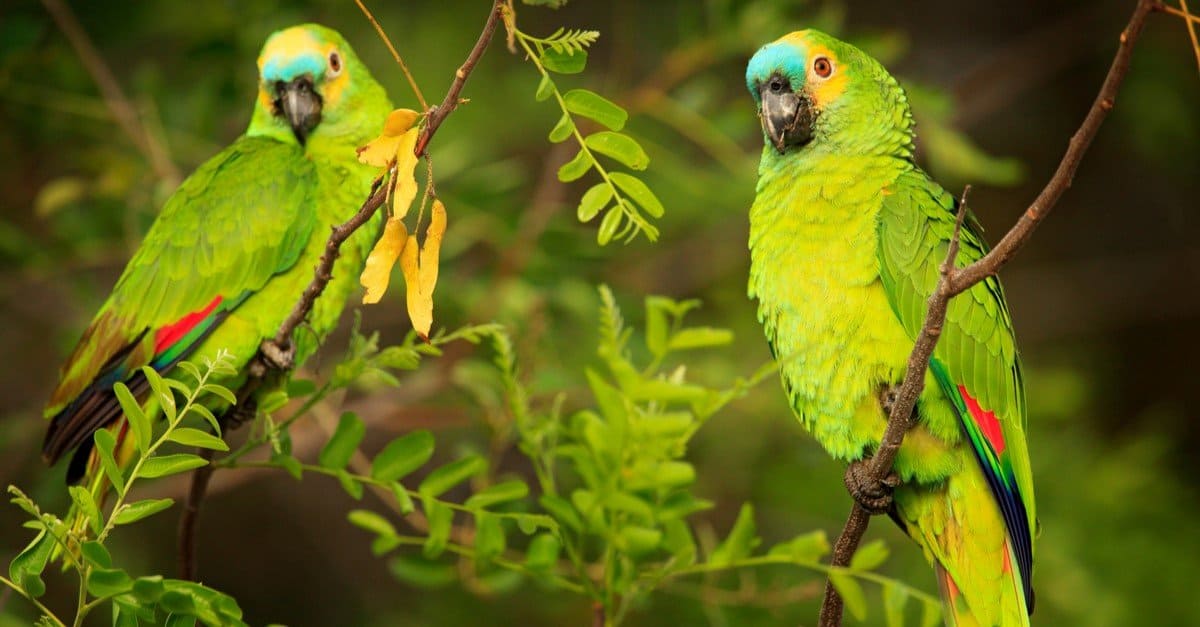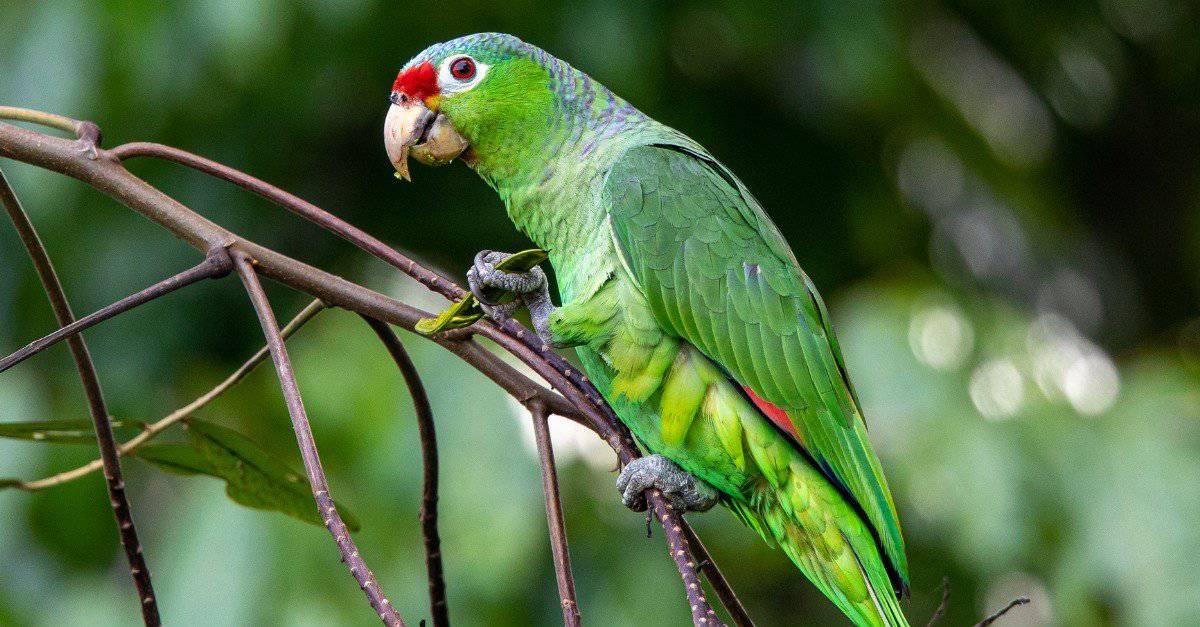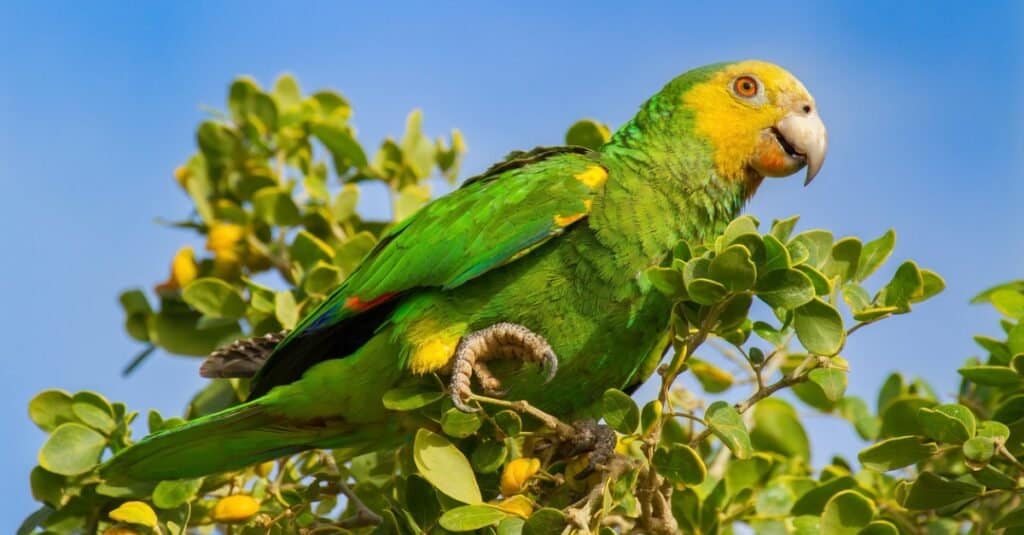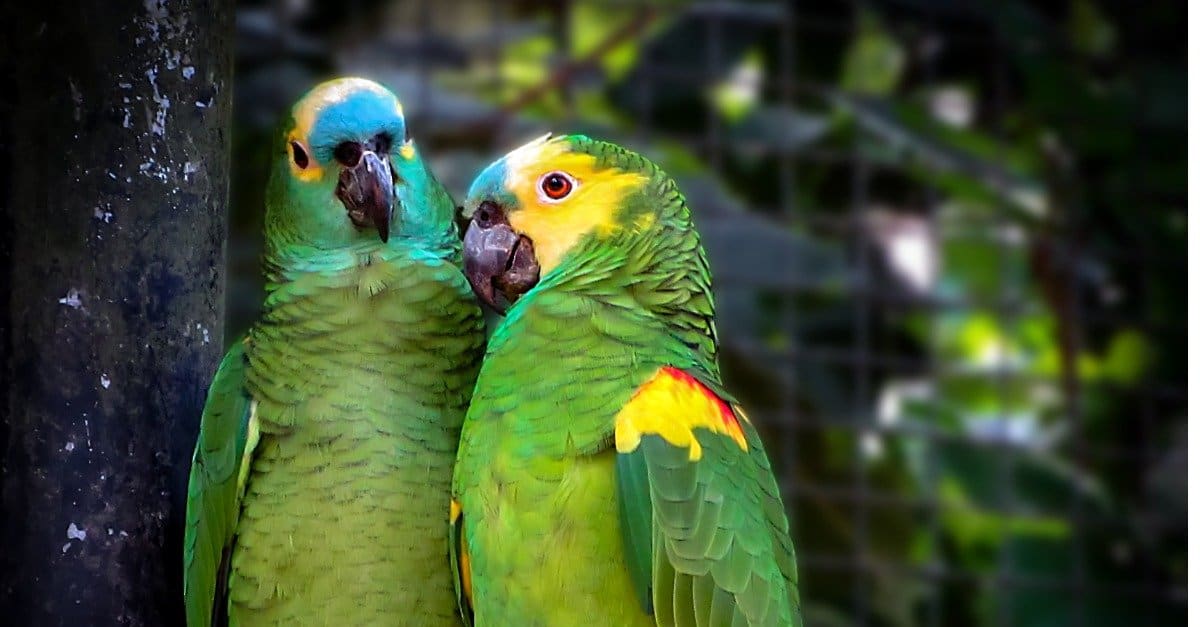Amazon Parrot
These parrots can be trained to be "talking birds" that mimic human speech
Advertisement
Amazon Parrot Scientific Classification
Amazon Parrot Facts
- Fun Fact
- These parrots can be trained to be "talking birds" that mimic human speech
- Estimated Population Size
- The populations of many wild Amazon parrots haven’t been quantified, but 58 percent of these parrots are now considered endangered as of 2021. As of 2020 there were 2361 yellow-naped Amazon parrots, and there are an estimated 9000 to 10,000 red-tailed amazons in the wild. On the other hand, the Imperial amazon is considered critically endangered, and there may be only 50 adult birds in the wild.
- Biggest Threat
- Pet trade, habitat destruction
- Most Distinctive Feature
- Their colorful feathers
- Other Name(s)
- Sisserou, turquoise-fronted parrot, yellow-shouldered parrot, mercenary amazon, red-tailed parrot, cuca
- Wingspan
- 8 inches to 11.26 inches
- Incubation Period
- About a month
- Litter Size
- Two to five
- Habitat
- Woodlands, savannas, rainforests, palm groves, cloud forests, moist forests, mountain forests
- Predators
- Monkeys, birds of prey, snakes
- Diet
- Herbivore
- Type
- Bird
- Common Name
- Amazon Parrot
- Number Of Species
- 35
- Location
- South America, the Caribbean, Mexico, South Africa, Europe
- Nesting Location
- Tree cavity
- Age of Molting
- Two months
View all of the Amazon Parrot images!
“An Amazon Parrot is a beautiful bird with lots of personality.”
Amazon parrots, which are often called amazons, are large members of the Psittacidae family. They are mostly native to South America. There are 35 species and several subspecies, and many can be trained to be talking birds to some extent. Physical features include big, powerful bills to crack the nuts they find in their native habitat and multicolored plumage. Mental features are high intelligence, curiosity, and a bold personality. Read on to learn more about these incredible birds.
See all of our expert product reviews.
4 Amazing Amazon Parrot Facts!
Here are four facts about the amazing Amazon parrot:
- The lifespan of some species can be as long as a century, something to consider if you want an Amazon parrot for a pet.
- The St. Vincent amazon is the national bird of St. Vincent and the Grenadines.
- Florida has over 12 species of Amazon parrots. Most of them live in and around Miami.
- Even if they’re not talking parrots, some amazons have different vocal dialects depending on where they live.

Where To Find The Amazon Parrot

Panama Amazon and Yellow-crowned Amazon are native to South America, Mexico, and the Caribbean.
©iStock.com/GlobalP
Amazon parrots are native to South America, the Caribbean, and Mexico, and feral parrots are found in the United States, Europe, and South Africa. These feral populations are thought to be the result of owners finding the needs or behavior of their pet parrots a bit too much to handle and setting them free.
Nests
Amazons tend to build their nests in cavities found in trees or cliffs. An exception is a Cuban amazon that lives in Abaco in the Bahamas. These parrots build their nests on the ground.
Health and Entertainment for your Amazon Parrot
See all of our expert product reviews.
Scientific Name
The scientific name of the genus is Amazona, which simply means they are of the Amazon. After this, the epithets have several meanings. The aestiva in A. aestiva, the scientific name of the blue-fronted parrot means “summer.” The epithet of A. brasiliensis means “of Brazil.” The epithet of A. agilis, the scientific name of the black-billed amazon means “agile” and the epithet of A. ventralis means “of the belly.” This is the scientific name of the Hispaniolan amazon, given because of the patch of red on its belly.
Evolution And History

Parrots are some of the most most beautiful green animals on the planet.
©Ondrej Prosicky/Shutterstock.com
The parrot is believed to have evolved over 59 million years ago, in Gondwana, the once ancient super subcontinent that formed after Pangaea broke up. Although scientists believed that birds evolved from an ancient bird-like dinosaur, Archaeopteryx, which is the oldest known fossil bird and was found in the Gobi Desert and lived during the Cretaceous period, over 100 million years ago.
The Amazon parrot was able to spread out to areas of the Caribbean around 3.5 million years ago, which is hypothesized to be because, during this time, the periods of the sea levels were lower, which is thought to have made travel easier from mainland Central America to the islands.
Types Of
The Amazona genus of parrots has over 35 species of birds. Here are just a few of those:
- Cuban Amazon (Amazona leucocephala) – found in Cuba, the Cayman Islands, and the Bahamas
- Puerto Rican Amazon (Amazona vittata) – is in Puerto Rico
- Red-spectacled Amazon (Amazona pretrei) – found in Brazil, Paraguay and Argentina
- Lilac-crowned Amazon (Amazona finschi) – located in Northwestern to southwestern Mexico
- Red-lored Amazon (Amazona autumnalis) – located in Central and South America
- Blue-cheeked Amazon (Amazona dufresniana) – lives in French Guyana, Guyana, Suriname, Venezuela
Appearance

These parrots are large birds, ranging in size from 9 to 18 inches.
©iStock.com/Jeff Edwards
Amazon parrots are relatively large birds. They range in size from the 9-inch long white-fronted amazon to the 18-inch long Imperial amazon. They are mostly green but usually come with areas of rich shades of red, blue, maroon, purple, and yellow. Their tails are short compared to other parrots, and their wings are round. Other features include heavy, hooked bills whose purpose is to crack nuts and other hard seeds and zygodactyl feet whose purpose is to cling tightly to branches. The parrots have a naked cere, which is that bit of flesh at the top of the bill.
It is difficult for humans to tell some male and female parrots such as the blue-fronted Amazons apart. The difference between males and females in some parrots is only apparent in the ultraviolet range, which humans can’t see. Males might be a bit larger in some species.
Behavior
Amazon parrots are social as a group and travel together in large flocks. They also nest in the same area. The purpose of this behavior is to give the birds protection from predators. They communicate both vocally and through gestures. The vocalizations of Amazon parrots are quite diverse and can be rather loud. Parrots scream, screech, growl, rumble, bugle, and squawk.
Amazons are also monogamous, by and large. The main social unit is the pair, which then interacts with the larger flock.
Does The Amazon Parrot Make A Good Pet?
Whether an Amazon parrot makes a good pet depends on several factors. The most important is probably the species. Some Amazon parrots even need behavior training, otherwise, they will become unruly or even violent toward their owner. Another thing to consider is the parrot’s conservation status. Some parrots are endangered because their eggs and chicks are collected so the birds can be sold in the pet trade.
Since parrots are monogamous, it is ideal to buy at least two, which can be expensive. The price of an Amazon parrot can range between $400 and $1000. They also need a lot of room as they are large birds. There’s not only the price of an enclosure for the birds but the price of their food, their toys, and their veterinary care. Parrots are messy and need to be bathed at least now and then. A potential owner must also remember that a young parrot might outlive them and make arrangements for their care.
Diet

Amazon Parrots are herbivores and in the wild eat a diet of nuts, seeds berries, flowers, and fruit.
©iStock.com/Ben-Schonewille
These parrots are herbivores, and their food includes nuts, seeds, berries, flowers, fruit, and leaves in the wild. In captivity, they can be given pellets formulated for parrots that are supplemented with fresh fruit and vegetables. They shouldn’t be fed seeds and nuts all the time because these items have too much fat, and obesity can be a problem with captive amazons. Of course, the parrot must have access to fresh water every day.
Predators And Threats
Humans are the biggest predators of and threats to Amazon parrots, for grown birds avoid predators by being large and congregating in flocks. Humans hunt parrots and even their eggs for the pet trade and hunt the larger parrots for food. The habitat of these parrots is also destroyed or fragmented by human housing, farms, and industry.
In the wild, predators are mostly a danger to chicks and eggs. They include hawks, snakes such as the boa constrictor, and monkeys.
Reproduction, Babies, And Lifespan

Amazon parrots are monogamous and breed seasonally, most usually in spring or late winter.
©iStock.com/Lucas Pacheco
The reproductive strategies of many species of these parrots are not well known by biologists, but they do know that parrots are monogamous and breed seasonally. Most breed in spring or late winter, though the blue-fronted parrot breeds in the summer, which probably gives it its scientific name.
Most parrots construct a nest in a tree cavity, and the female lays between two and five eggs, which she incubates for about a month. During that time the male feeds her, then helps her feed the chicks, which are born helpless. Chicks are fledged after about two months. Biologists don’t know when many of these parrots reach maturity, but it’s believed that blue-fronted parrots are mature when they’re two to four years old. Amazon parrots are amazingly long-lived and can have a lifespan of as long as 100 years if they are given good care.
Population
The conservation status of an amazon depends on its species. For example, the red-spectacled amazon of Argentina is listed as vulnerable. The black-billed Amazon is endangered, the Cuban amazon is near threatened and the white-fronted amazon is of least concern.
View all 194 animals that start with AAmazon Parrot FAQs (Frequently Asked Questions)
Does the Amazon Parrot Migrate?
Amazon parrots don’t migrate. They are considered “sedentary,” which means they don’t travel far from their home.
How many eggs does an Amazon Parrot lay?
An Amazon parrot lays between two and five eggs.
How fast does the Amazon Parrot fly?
The parrot can fly between 40 and 50 miles per hour.
What is the Amazon Parrot’s wingspan?
The wingspan of the bird depends on its species and ranges from 8 inches for the white-fronted amazon to 11.26 inches for the Imperial parrot.
When do Amazon Parrots leave the nest?
Amazon parrot chicks leave the nest when they’re about two months old.
How much is an Amazon parrot?
The price of an Amazon parrot can range between $400 and $1000.
Are Amazon parrots good for beginners?
These parrots are not good pet birds for beginners! They need a lot of room, a lot of exercise, and a lot of mental stimulation.
Are Amazon parrots aggressive?
Some amazons have a forceful personality and can be aggressive towards their owners if they’re not properly trained or kept mentally stimulated.
Why do Amazon parrots smell?
Like everything else, Amazon parrots smell because they’re not clean. Captive parrots make messes and need to be bathed fairly regularly.
Thank you for reading! Have some feedback for us? Contact the AZ Animals editorial team.
Sources
- ITIS / Accessed October 31, 2021
- Wikipedia / Accessed October 31, 2021
- Lafeber Company / Accessed October 31, 2021
- The Spruce Pets / Accessed October 31, 2021
- BBC / Accessed October 31, 2021


















